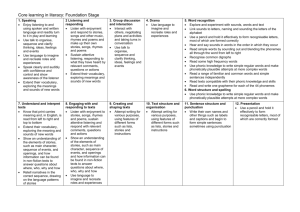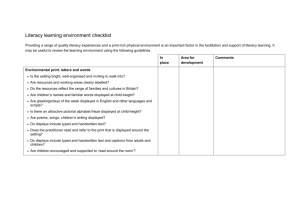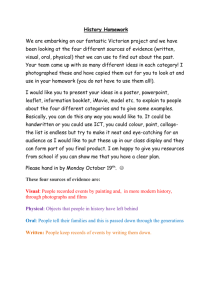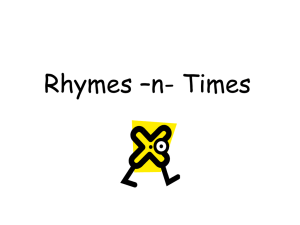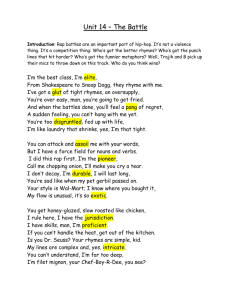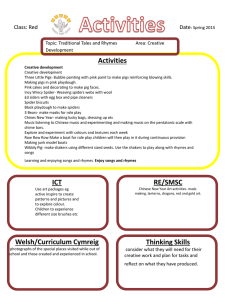Learning and Teaching Communication, Language and Literacy in
advertisement
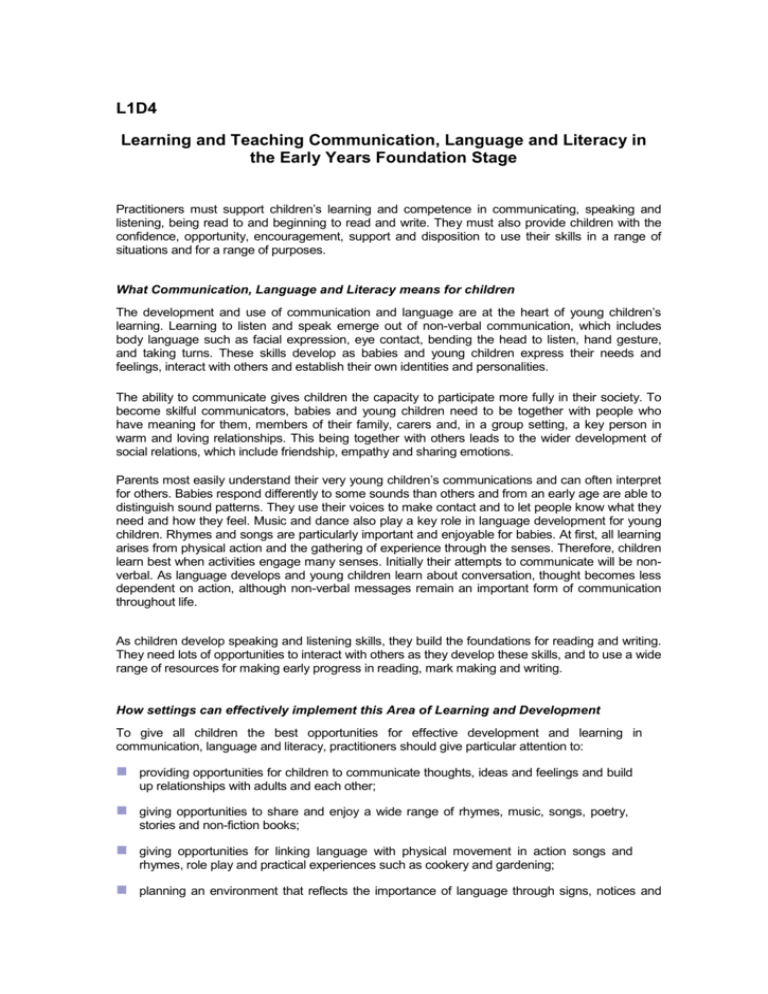
L1D4 Learning and Teaching Communication, Language and Literacy in the Early Years Foundation Stage Practitioners must support children’s learning and competence in communicating, speaking and listening, being read to and beginning to read and write. They must also provide children with the confidence, opportunity, encouragement, support and disposition to use their skills in a range of situations and for a range of purposes. What Communication, Language and Literacy means for children The development and use of communication and language are at the heart of young children’s learning. Learning to listen and speak emerge out of non-verbal communication, which includes body language such as facial expression, eye contact, bending the head to listen, hand gesture, and taking turns. These skills develop as babies and young children express their needs and feelings, interact with others and establish their own identities and personalities. The ability to communicate gives children the capacity to participate more fully in their society. To become skilful communicators, babies and young children need to be together with people who have meaning for them, members of their family, carers and, in a group setting, a key person in warm and loving relationships. This being together with others leads to the wider development of social relations, which include friendship, empathy and sharing emotions. Parents most easily understand their very young children’s communications and can often interpret for others. Babies respond differently to some sounds than others and from an early age are able to distinguish sound patterns. They use their voices to make contact and to let people know what they need and how they feel. Music and dance also play a key role in language development for young children. Rhymes and songs are particularly important and enjoyable for babies. At first, all learning arises from physical action and the gathering of experience through the senses. Therefore, children learn best when activities engage many senses. Initially their attempts to communicate will be nonverbal. As language develops and young children learn about conversation, thought becomes less dependent on action, although non-verbal messages remain an important form of communication throughout life. As children develop speaking and listening skills, they build the foundations for reading and writing. They need lots of opportunities to interact with others as they develop these skills, and to use a wide range of resources for making early progress in reading, mark making and writing. How settings can effectively implement this Area of Learning and Development To give all children the best opportunities for effective development and learning in communication, language and literacy, practitioners should give particular attention to: providing opportunities for children to communicate thoughts, ideas and feelings and build up relationships with adults and each other; giving opportunities to share and enjoy a wide range of rhymes, music, songs, poetry, stories and non-fiction books; giving opportunities for linking language with physical movement in action songs and rhymes, role play and practical experiences such as cookery and gardening; planning an environment that reflects the importance of language through signs, notices and books; providing opportunities for children to see adults writing and for children to experiment with writing for themselves through making marks, personal writing symbols and conventional script; providing time and opportunities to develop spoken language through conversations between children and adults, both one-to-one and in small groups, with particular awareness of, and sensitivity to, the needs of children learning English as an additional between children and adults, both one-to-one and in small groups, with particular awareness of, and sensitivity to, the needs of children learning English as an additional language, using their home language when appropriate; providing time and opportunities to develop their phonological awareness through small group and individual teaching, when appropriate; planning opportunities for all children to become aware of languages and writing systems other than English, and communication systems such as signing and Braille; early identification of and response to any particular difficulties in children’s language development; close teamwork between bilingual workers, speech therapists and practitioners, where appropriate; opportunities for children who use alternative communication systems to develop ways of recording and accessing texts to develop their skills in these methods. The EYFS and the revised Literacy Framework By the end of the Early Years Foundation Stage (EYFS), the expectation is that most children will achieve the early learning goals for CLL. These have been re-ordered in the literacy framework so that practitioners can see how they dovetail into the framework’s 12 strands of speaking, listening, reading and writing. All the early learning goals are included and remain the same as in the EYFS. They are reproduced below with the number of the literacy framework strand beside each one. Language for Communication Interact with others, negotiating plans and activities and taking turns in conversation (3) Enjoy listening to and using spoken and written language and readily turn to it in play and learning (1) Sustain attentive listening, responding to what they have heard by relevant comments, questions or actions (2) Listen with enjoyment and respond to stories, songs and other music, rhymes and poems and make up their own stories, songs, rhymes and poems.(2) (8) Extend their vocabulary, exploring the meanings and sounds of new words (1) Speak clearly and audibly with confidence and control and show awareness of the listener, for example by their use of conventions such as greetings, ‘please’ and ‘thank you’. (1) Language for Thinking Use language to imagine and recreate roles and experiences (1) (4) Use talk to organise, sequence and clarify thinking, ideas, feelings and events (1) (3) Linking Sounds and Letters Hear and say sounds in words in the order in which they occur. (this amended ELG is currently the subject of a consultation process) (5) Link sounds to letters, naming and sounding the letters of the alphabet. (5) Use their phonic knowledge to write simple regular words and make phonologically plausible attempts at more complex words (6)(11) Reading Explore and experiment with sounds, words and texts (5) Retell narratives in the correct sequence, drawing on the language patterns of stories(7) Show an understanding of the elements of stories, such as main character, sequence of events, and openings, and how information can be found in non-fiction texts to answer questions about where, who, why and how. (7) (8) Read a range of familiar and common words and simple sentences independently (5) Know that print carries meaning and, in English, is read from left to right and top to bottom.(7) Writing Use their phonic knowledge to write simple regular words and make phonetically plausible attempts at more complex words (5) Attempt writing for various purposes, using features of different forms such as lists, stories and instructions (9) (10) Write their own names and other things such as labels and captions and begin to form simple sentences sometimes using punctuation.(11) Handwriting Use a pencil and hold it effectively to form recognisable letters, most of which are correctly formed.(12) Effective practice to help children progress towards the Early Learning Goals in Language for Communication: Explore and talk about things which interest young children indoors and outdoors and listen and respond to their questions Support children in using a variety of communication strategies, including signing where appropriate Listen to children and take account of what they say in your responses to them Share rhymes and stories from many cultures Set up a listening area where children can enjoy music, rhymes and stories Give children clear directions and help them to respond to those involving more than one action Provide practical experiences that encourage children to ask and respond to questions Introduce new words in the context of play and everyday activities Show interest in the words children use to communicate and describe their experiences Help children expand on what they say, introducing and reinforcing the use of more complex sentences Encourage conversation wit others and demonstrate appropriate conventions – taking turns, waiting until someone else ahs finished, listening to others. Show children how to use language for negotiating in your interactions with them Model language appropriate for different audiences Encourage children to predict possible endings to stories and events Encourage children to experiment with words and sounds, for example in nonsense rhymes Encourage children to sort, group and sequence in their play. Use words such as first, last, next, before, after, all, most, some each and every Encourage language play, for example, through stories like ‘Goldilocks’ and action songs that require intonation Value children’s contributions and use them to inform and shape the direction of discussions Effective Practice to help children progress towards the Early Learning Goals for Communication for Thinking: Encourage children to talk about how they feel, for example after a disagreement, when they are excited at seeing snow, or at the birth of a sibling Create a story with children, asking them to predict what will happen next Ask children to tell you about what they are going to do before they do it, and ask them to suggest possible outcomes, for example, ‘It might break because there are too many in it’ Help children to identify patterns and draw conclusions, for example, ‘The sky has gone dark, it must be going to rain’, explain effect, ‘It sank because it was too heavy, predict, ‘It might not grow in there if it is too dark’, and speculate, ‘What if the bridge falls down?’ Ask children to give reasons, further explanations or evidence for what they say Ask children to think in advance about how they will accomplish a task. Talk through and sequence the stages. Use stories to focus children’s attention on predictions and explanations, for example, ‘Why did the boat tip over?’ and general patterns, for example, what usually happens to the ‘good’ and ‘wicked’ characters in stories Take an interest in what and how children think and not just what they know Encourage children to explore and ask about the meanings of words Encourage children to explain sometimes how things work in words rather than actions Effective practice to help children progress towards the Early Learning Goals in Linking Sounds and Letters When singing or saying rhymes, talk about the similarities in the rhyming words. Make up alternative endings and encourage children to supply the last word of the second line, for example, Hickory, Dickory, boot, the mouse ran down the ….?’ Talk to children about the letters that represent the sounds they hear at the beginning of their own names and other familiar words. Incorporate these in games Demonstrate writing so that children can see spelling in action, Encourage them to apply their own knowledge of sounds to what they write Use a large phoneme frame with groups of children and give them small magnetic ones of their own, so that they become more confident to use their phonic knowledge in spelling Ensure that role-play areas encourage writing with a real purpose, such as lists or menus Plan games that help children create rhyming strings of real and imaginary words Plan a range of activities as part of the daily, systematic phonics session to teach grapheme/phoneme correspondences Provide opportunities for children to practise and apply their skills in freely chosen activities For children in reception, plan the daily discrete phonic session carefully bearing these points in mind: The children have been carefully assessed, including exploring the boundaries of their phonic knowledge Assessments are used to plan the next steps in learning, in accordance with the principles of effective Assessment for Learning The sessions are pitched at the appropriate step so learning is ‘incremental’ The sessions reinforce and build on recent learning The sessions are engaging, pacey and use multi-sensory activities Children have the opportunity to practise any new knowledge, e.g. identifying new grapheme/phoneme correspondences, or practising blending and segmenting During the course of the session, at the point of learning, the children should see how the new learning can be applied and contextualised by the teacher/practitioner modelling it e.g. by writing a short sentence that includes a CVC word which can be segmented, or reading a phrase or short sentence that is phonically decodable. Effective Practice to help children progress to the Early Learning Goals for Reading Focus on meaningful print, such as a child’s name, favourite cereal or book, in order to discuss similarities and differences between symbols Help children to understand what a word is, by using names and labels and by pointing out words in the environment and in books Read stories that children already know, pausing at intervals to encourage them to ‘read’ the next word Create imaginary words to describe characters in stories and poems Discuss ways of finding out information from non-fiction texts Explain to parents the importance of reading to children, ask about favourite books, and offer book loans Help children identify the main events in a story and to enact stories, as the basis for further imaginative play Make story boxes with the children Demonstrate the reading strategy of reading using phonics first while children can see the text, for example, using big books Encourage children to recall words they see frequently Play games which develop children’s grapheme-phoneme correspondence, so that they can rapidly decode words Effective Practice to help children progress to the Early Learning Goals for Writing Draw attention to marks, sigs and symbols in the environment and talk about what they represent Make books with children of activities they have been doing, using photographs of the children as illustrations Write poems and short stories with the children Encourage the children to use their phonic knowledge when writing Act as a scribe for children. After they say the sentence, repeat the first part and say each word as your write and include some punctuation When writing, talk about what you are doing and why, and talk through some of your decisionmaking on the way, such as what to write, choice of words and their order. Continually reread the writing to provide a good model for children when they write Encourage children to reread their writing as they write Provide materials and opportunities for children to initiate the use of writing in their play, as well as creating purposes for independent and group writing Plan occasions where you can involve children in organising writing, for example, putting recipe instructions in the right order Effective Practice to help children progress towards the Early Learning Goals for Handwriting Encourage children to handle and manipulate a variety of media and implements, for example, clay, finger paints, brushes etc Provide activities that give children the opportunity and motivation to practise manipulative skills, for example, cooking and playing instruments Teach children to form letters correctly, for example, when they label their paintings Encourage children to practise letter shapes as they paint, draw and record, and as they write, for example, their names, the names of their friends and family or captions Continue writing practice in imaginative contexts, joining some letters, if appropriate, for example ‘at’, ‘it’, ‘on’ Give children extensive practice in writing letters, for example labelling their work, making cards, writing notices Provide a variety of writing tools and paper, indoors and outdoors Provide opportunities to write meaningfully, for example, by placing notepads by phones or having appointment cards in the ‘doctor’s surgery’ Developing Communication, Language and Literacy learning across a week in reception Every day Children are provided with: opportunities throughout the day, inside and outside, to engage independently in speaking, listening, reading and writing activities across the curriculum which allow them to explore and practise their growing phonic knowledge and blending and segmenting skills; an interactive multi-sensory phonics session, led by the teacher/practitioner, comprising direct teaching and opportunities to practise and apply new learning; a session led by the teacher/practitioner of shared reading and/or shared writing so that reading and writing strategies, including the use of phonics, are clearly demonstrated in a purposeful context; opportunities to hear a wide-ranging selection of stories, poems, rhymes and non-fiction as part of a regular read-aloud programme. Twice a week Children take part in: Guided reading with the teacher/practitioner. These small-group sessions will be planned to support the development of reading strategies and skills according to the needs and experience of children. Once a week minimum Children take part in: guided writing with a teacher/practitioner, where, as part of a group, they have the opportunity to develop their writing skills (including oral rehearsal) with support. The context for the writing could derive from any area of the curriculum, and indeed over time should do so.

